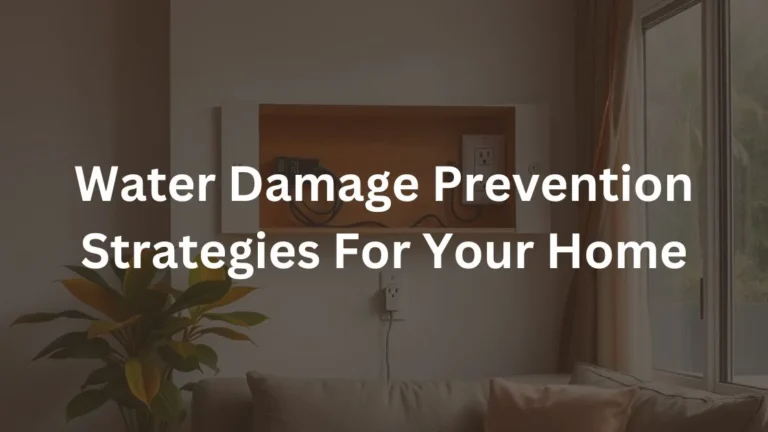Water and electricity are a dangerous combination that can lead to severe damage and safety hazards in your home. Protecting your electrical systems from water damage is crucial for ensuring the safety and efficiency of your home’s electrical infrastructure.
In this article, we’ll explore practical strategies to safeguard your home electrics from potential water damage, helping you maintain a safe and functional living environment while avoiding costly repairs.
- Water exposure can lead to dangerous short circuits, corrosion, and increased risks of electrocution.
- To protect your electrical systems, ensure you turn off the main power when dealing with water, and consider using waterproof components such as RCD sockets.
- Regular inspections by professionals can identify vulnerabilities and replace any damaged parts. Furthermore, investing in waterproofing solutions enhances safety and ensures compliance with building regulations.
Proactive measures are key to preventing water-related hazards, so take the time to explore effective strategies tailored to your home’s specific needs.
Impact of Water Damage on Electrical Systems
Water damage can severely compromise the integrity of electrical systems, leading to a cascade of potential hazards that homeowners must take seriously.
The corrosion effects on wires and circuit breakers can greatly heighten the risk of electrical failures, impacting not only system efficiency but also household safety.
When water interacts with live wires, it can create dangerous short circuits, resulting in power surges that may damage essential appliances.
Furthermore, ongoing exposure can facilitate earth faults, allowing electricity to travel through unintended paths, which poses a severe electrocution risk.
As these issues escalate, repair costs can balloon due to the need for extensive replacements.
Protecting your home’s electrical infrastructure from water damage is vital for ensuring a safe, functional living environment for you and your family. Learn more about preventing water leaks in your home.
Dangers of Water-Damaged Electrical Systems
The risks associated with water-damaged electrical systems cannot be overstated. When electrical components come into contact with moisture, they become prime candidates for electrocution risks that can lead to life-threatening shocks.
Furthermore, water exposure can cause short circuits, resulting in power surges that not only damage appliances but also heighten the risk of electrical fires.
Corrosion of wires and circuit breakers further diminishes the efficiency of your electrical system, making it less reliable over time.
Malfunctioning appliances, stemming from water damage, jeopardise user safety and may lead to further hazards in your home.
Safety Precautions During Water Exposure
When faced with the threat of water exposure around electrical systems, your home’s safety hinges on taking immediate and decisive action.
Initially, turn off the main power supply at the consumer unit to eliminate any risk of electrocution. Avoid contact with standing water near sockets and appliances; this is vital in preventing electrical shocks.
Equip yourself with insulated tools, gloves, and rubber footwear when handling electrical components in damp conditions. Consider using waterproof materials for temporary barriers if possible.
Document any water damage thoroughly, including photographs and descriptions, as this will aid in insurance claims.
Remember, the importance of proper electrical insulation cannot be overstated; it’s often your primary line of defence against water-related hazards.
Stay vigilant and prioritise safety.
Professional Inspection and Repair
After experiencing water exposure in your home, seeking a professional inspection and repair for your electrical system is essential.
Expert electricians conduct thorough electrical assessments to identify the full extent of water damage, ensuring no affected areas are overlooked. Using advanced repair techniques, they replace corroded or damaged components, such as wires and sockets, restoring your system to safe operational standards.
Following these repairs, functionality testing is performed to confirm that all electrical components operate safely and efficiently, reducing future risks.
Furthermore, electricians often recommend preventative measures, such as installing Residual Current Devices (RCDs), to enhance safety in moisture-prone areas.
Water Damage Prevention Strategies
To effectively safeguard your home from the risks associated with water damage, implementing proactive prevention strategies is vital. Regular electrical maintenance and inspections can help identify potential water intrusion risks, especially around roofs and plumbing. Learn more about the dangers of ignoring a leaking sink.
Installing waterproof components, such as RCD (Residual Current Device) outlets in moisture-prone areas, reduces electrical hazards. Furthermore, maintaining drainage systems ensures effective water redirection away from your foundation.
| Strategy | Description | Benefits |
|---|---|---|
| Regular Inspections | Check for leaks and vulnerable areas | Early detection of moisture risks |
| Waterproof Components | Use RCD outlets in kitchens and bathrooms | Enhanced safety against electrical shocks |
| Drainage Maintenance | Clean gutters and downpipes regularly | Prevents flooding and moisture intrusion |
| Waterproof Techniques | Apply silicone sealant around outlets | Creates a barrier against water entry |
| Emergency Preparedness Plan | Keep contact information for electricians handy | Quick response to potential damage |
Importance of Waterproofing Solutions
Waterproofing solutions are essential for creating effective barriers that protect your home’s electrical systems from water infiltration.
By engaging professional waterproofing services, homeowners can ensure comprehensive assessments and tailored strategies that significantly reduce risks and enhance safety.
Investing in high-quality waterproofing measures not only safeguards your electrical components but also prolongs their lifespan, providing peace of mind for years to come.
Effective Barrier Creation
Creating an effective barrier against water intrusion is essential for safeguarding home electrics from potential hazards.
Implementing waterproofing solutions not only protects your home’s electrical systems but also enhances overall safety.
Here are three key strategies to take into account:
- Barrier Types: Employ waterproof materials such as RCD (Residual Current Device) sockets specifically designed for moisture-prone areas like kitchens and bathrooms.
- Sealing Techniques: Apply silicone sealant around electrical sockets to create a robust seal against moisture.
- Regular Maintenance: Consistently apply waterproof coatings to external surfaces to shield electrical systems from heavy rainfall and flooding.
Professional Waterproofing Services
Professional waterproofing services play a vital role in protecting your home’s electrical systems from the devastating effects of water damage. By implementing tailored solutions with high-quality waterproofing materials and advanced waterproofing techniques, these experts create effective barriers against water intrusion. This not only mitigates electrical hazards but also enhances safety and compliance with local building regulations, ensuring the longevity of your installations.
| Benefit | Description |
|---|---|
| Reduced Risk | Minimises potential electrical hazards from water damage. |
| Lower Insurance Costs | Prevents claims, potentially lowering premiums. |
| Regular Maintenance | Identifies vulnerabilities in waterproofing. |
| Safety Compliance | Guarantees GFCI outlets in moisture-prone areas. |
Investing in professional waterproofing is a proactive step towards a safer home.
Key Takeaways
- Turn off the main power supply immediately during water exposure to eliminate the risk of electrocution.
- Install waterproof electrical components, such as RCD sockets, in areas prone to moisture.
- Seal around electrical sockets with silicone to prevent water entry and infiltration.
- Schedule regular professional inspections to identify and address potential water intrusion risks.
- Maintain proper drainage systems to keep water away from your home’s foundation and electrical systems.
Do you have water damage to your property?
Northern Ireland’s expert Loss Assessor service is here to help you claim the settlement you’re entitled to!
Dealing with water damage can be a daunting and stressful experience. Imagine having a team of experts by your side, guiding you through the entire claims process. Our trained professionals specialise in water damage claims, ensuring your case is managed efficiently and thoroughly.
Picture the relief you’ll feel knowing a dedicated professional is advocating for your best interests, maximising your settlement, and handling all the paperwork. Our meticulous approach means you can focus on recovering and restoring your property while we take care of your claim.
Don’t let water damage claims overwhelm you. Contact PCLA, Northern Ireland’s most trusted Loss Assessor service today for a free consultation.



